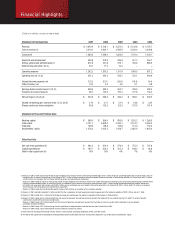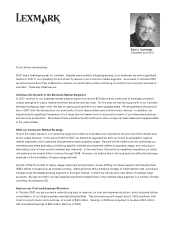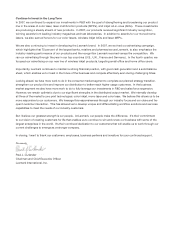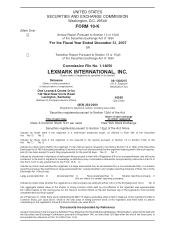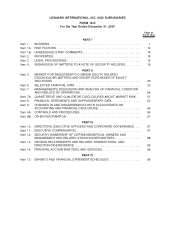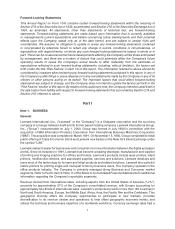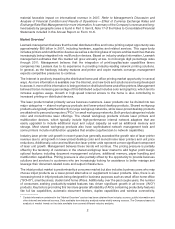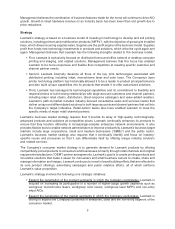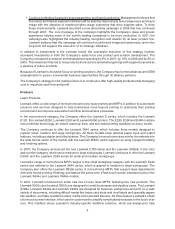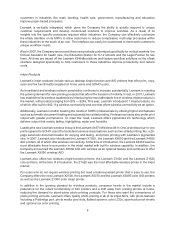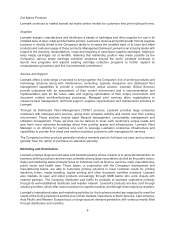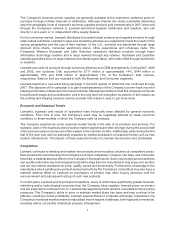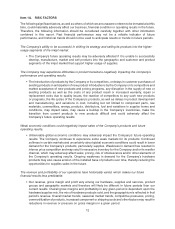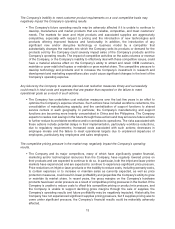Lexmark 2007 Annual Report Download - page 9
Download and view the complete annual report
Please find page 9 of the 2007 Lexmark annual report below. You can navigate through the pages in the report by either clicking on the pages listed below, or by using the keyword search tool below to find specific information within the annual report.
Management believes the combination of business features made for the home will continue to drive AIO
growth. Growth in inkjet hardware revenue on an industry basis has been lower than unit growth due to
price reductions.
Strategy
Lexmark’s strategy is based on a business model of investing in technology to develop and sell printing
solutions, including printers and multifunction products (“MFPs”), with the objective of growing its installed
base, which drives recurring supplies sales. Supplies are the profit engine of the business model. Supplies
profit then funds new technology investments in products and solutions, which drive the cycle again and
again. Management believes that Lexmark has the following strengths related to this business model:
• First, Lexmark is exclusively focused on distributed home and office network or desktop computer
printing and imaging, and related solutions. Management believes that this focus has enabled
Lexmark to be more responsive and flexible than competitors at meeting specific customer and
channel partner needs.
• Second, Lexmark internally develops all three of the key print technologies associated with
distributed printing, including inkjet, monochrome laser and color laser. The Company’s laser
printer technology platform has historically allowed it to be a leader in product price/performance
and also build unique capabilities into its products that enable it to offer customized solutions.
• Third, Lexmark has leveraged its technological capabilities and its commitment to flexibility and
responsiveness to build strong relationships with large-account customers and channel partners,
including major retail chains, distributors, direct-response catalogers and value-added resellers.
Lexmark’s path-to-market includes industry-focused consultative sales and services teams that
deliver unique and differentiated solutions to both large accounts and channel partners that sell into
the Company’s target industries. Retail-centric teams also have enabled Lexmark to meet the
specific needs of major retail channel partners.
Lexmark’s business market strategy requires that it provide its array of high-quality, technologically-
advanced products and solutions at competitive prices. Lexmark continually enhances its products to
ensure that they function efficiently in increasingly-complex enterprise network environments. It also
provides flexible tools to enable network administrators to improve productivity. Lexmark’s business target
markets include large corporations, small and medium businesses (“SMBs”) and the public sector.
Lexmark’s business market strategy also requires that it continually identify and focus on industry-
specific issues and processes so that it can differentiate itself by offering unique industry solutions
and related services.
The Company’s consumer market strategy is to generate demand for Lexmark products by offering
competitively-priced products to consumers and businesses primarily through retail channels and original
equipment manufacturer (“OEM”) partner arrangements. Lexmark’s goal is to create printing products and
innovative solutions that make it easier for consumers and small business owners to create, share and
manage information and images. Lexmark continues to invest in brand building efforts that are reflected in
its core product offerings, advertising campaigns and public relations efforts, all of which reinforce
Lexmark’s value proposition.
Lexmark’s strategy involves the following core strategic initiatives:
•Expand the penetration of the product segments in which the Company participates. Lexmark is
focused on increasing its participation in a number of higher-usage growth segments such as
workgroup monochrome lasers, workgroup color lasers, workgroup laser MFPs and non-entry
inkjet AIOs.
•Expand the penetration of the market segments in which the Company participates. Lexmark is
driving to expand the Company’s presence in enterprise, SMB and the non-entry segment of the
consumer market.
3


